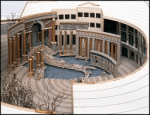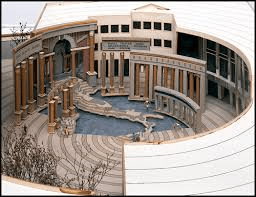In preparation to this session, Dr Westerside asked us to read two texts; from a book called “Postproduction”[1] and from “The Postmodern”[2].
One can’t start explaining what postmodern theatre is without mentioning what is postmodernism as an idea and what id modernism itself. And so did we. The session begun with defining what modernism is. It defines since the industrial revolution towards the future. There’s a big narrative that units to human race to move forward, there’s an abstract that brings to the core of truth. Dr Westerside gave as an example Mondrian’s Composition 8.
The work is non-realistic but still it’s very define and the limits are clear. (more on that work here à http://www.guggenheim.org/new-york/collections/collection-online/artwork/3008
Modernism is the digging towards originality, its drifting away from everything that came before it, it’s the change, the new, the innovation. Modernism is the contemporary expressed in artistic means. The modern artist must change with time, to explore, to wonder to initiate. Robert Rauschenberg on the other side, as a postmodern artist presenting mixed techniques, a mess, more of a process than a finished piece.
(More on the artist here à https://www.artsy.net/artist/robertrauschenberg )
Dr Westerside also mentioned le Corbusier famous quote:” a house is a machine for living in”. Well that’s modernism. Everything is functional and has a purpose. Postmodernism architecture is making a parody to other styles.
The first strategy of postmodernism is eclecticism. Collecting similar ideas and re-edit them. Mixing ideas, subjects, issues, techniques and practises from different eras and cultures. It’s a Pastiche with no hierarchy, a field of strategies. In architecture, if bauhouse represent everything functional and modern then Charles Moore’s Piazza d`Italia in New Orleans is the opposite.
Moore were asked to create a shopping center in a neighborhood with Italian migrant’s roots. He designed an Italian piazza with the looks of roman ruins with a neoclassic influence but with new materials like neon lights and abstract sculptures. It created an odd mixture, ironic, not neccerealy beautiful but with the ability to create unity in a city with French African, Italian and South American population. One cannot approach to a place like this a modernist and standardize it because this place is everything but standard. What Moore did her as a postmodern architect is to introduce this cultural mix with something new. It’s a show, interfering in the public space against the order of the modern.( More on that à http://www.dezeen.com/2015/08/21/postmodern-architecture-piazza-d-italia-charles-moore-new-orleans/ )#
Post modernism is highlighting the process. We watched part of the work of the Wooster group that showed the creative process and the actual artistic product at the same time. (More on the Wooster group à http://thewoostergroup.org/blog/ )
Postmodern philosophy is about how I know what I know. For example, we talked in class about the German flag. Each of the stipes carry its own meaning but it has also meaning that comes from being part of the whole. A part is belong to a certain whole, to other parts and to a certain symbolic order. How can you know what is the whole? The look is in the doubt, we are limits by our look and in these limits we are limited. This is framing. How to define unity? What is a part and what is a whole? How can one define meaning, truth or any relationship with the world? Concept is what connect us as individuals to the world.by using concept we pretend that everything is explainable and whole. The self is freed from that. The self is free from those kinds of barriers that im given to myself directly. One self-perception can sometimes lie the only thing that doesn’t subverts is the actual action of thinking. Its sharpening cogito ergo sum. I ask if I am. If I’m thinking I must be in this moment. Any thinking action validate the self. I position myself opposite or against what around me and this how I define my self.. Therefore the limits of the concept of myself is the limits of my world. We mentioned on that time Judith butler and Wittgenstein
Its definition vs. taxonomy. A doubt about knowledge .absolute, centrality of the self, relativity, acknowledgment of the instability of a concept. A concept that belongs to other systems, perceptions and other wholes. It’s like a sea of marbles that keeps changing and moving.
“As set of critical, strategic and rhetorical practises employing concepts such as difference, repetition, the trace, the simulacrum and hyper reality to destabilize other concepts such as presence identity, historical progress, epistemic certainty and the univoicity of meaning” (Aylesworth,2008, from the slideshow of this session)
It’s not relativism but something that comes against. In the slideshow there was also this table:
| modernism | postmodernism |
| Form (conjunctive/closed) | Antiform (disjunctive/open) |
| Purpose | Play |
| Design | Chance |
| Hierarchy | Anarchy |
| Art object/ Finished work | Process/ performance/ happenings |
| presence | Absence |
| Centring | Dispersal |
| Genre/ Boundary | Text/ Intertext |
| Root/ Depth | Rhizome/ Surface |
Then we watched the short film “Everything is a Remix” by Kirby Ferguson. (More on the video à http://everythingisaremix.info/ ) That video for me, is where art is going. Everything is a remix so we should remix it wisely.
There are few other elements, beside eclecticism in postmodernism we didn’t mention in class. The first one is parody. The parody in that sense can be taken as a continuation to the eclecticism. If the eclecticism cancelled the hierarchies, collected and mixed the parody usually focus on one thing, one element, idea, text, and “rides” on that. Creating an impression, mocking it by exposing the side that so sure of itself in that element. A good example for that would be the Allen Memorial Art Museum in Oberlin, Ohio by the architecture Robert Venturi. The building combines few different styled without trying to make any connection between them.
(More on that à http://www.oberlin.edu/amam/default.html )
Another example for that id Cindy Sherman’s the untitled film stills series from the 7o’s. Sherman presented a series of classic photographs of herself (the usage of the word classic is also a parody on the language itself) that relates to the American cinema. It looks like a picture from an old Hollywood film as she imitate the photos her generation grew up with. She becomes the star of her own film but she is completely different from a photo to photo so there’s no narrative been built. By that she creates double parody. On classic Hollywood and on the attempt to create images that demands totality from the artist.
(more on that à http://www.moma.org/interactives/exhibitions/1997/sherman/ )
Sherman is also using another postmodern technique which is the ironic stand or the ironic point of view. Its awarenes to the presence of the lack of knowledge. Pretending to not knowing something points on double meaning in the work. It’s like when Duchamp id positing a urinal in the gallery. He pretends that for him that’s a fountain and that brings more meanings. It’s deconstructive. It points on the death of the author and the lack of effectivity of the perception of the artist’s originality because it is always ironic to the work itself about its originality and about being an origin of something. Roee Rozen in his work “Live and Die as Eva Braun” (1997, London) is both a parody an ironic about the memory of the holocaust. The work is eclectic and present an accumulation of styles and parodies. It’s a parody on historical facts and perception because it is asking the audience to be in the position of the victimiser, Hitler’s lover. The work is also presenting an ironic innocence because the audience understand that this work is not about Hitler’s bunker or the relationship he had with brown and it’s not mentioning the holocaust at all. (more on that work à http://roeerosen.com/tagged/Live-and-Die-as-Eva-Braun )
Another elements of the postmodern art are lists, archives and categorization and simulacra. The listing, archives and categorization in postmodernism flatten everything. Nothing has meaning anymore. On Kawara works are exploring that starting from his “Today” series to “One Million Years” and more.
(more on that à http://www.moma.org/collection/artists/3030 )
Simulacra means that nothing have an origin it’s all a pile of quotation (what the video, everything is remix is claiming). The ongoing never ending copying making it impossible to define what is original and what is a copy. Andy Warhol is exploring that in his works.
The reading was exactly what we discussed about in class and was a good preparation to be based on.
[1] Bourriaud, Nicolas, Postproduction, Lukas & Sternberg, New York 2002, 0-41
[2] Malpas,Simon, The Postmodern, Routledge, 2005, 11-31

